As of today, June 11, 2013, it’s been revealed the the U.S. government has been snooping in every email, every text message, every online chat and probably every other form of communication for quite a while. Your privacy is gone, you probably know that already, and we think it’s going to be a long time before you get that privacy back. We think that it’s not only the U.S. that is doing this. We’re in Canada and we’re quite sure it’s happening here, too.
How does all of this affect you? You’re probably saying, “I’m not doing anything illegal. I’ve got nothing to worry about”. That may well be true but this spying could affect your life in many different ways. Do you bank online? Do you do your taxes online? As you know, your tax information is supposedly between you and your tax department. It doesn’t matter if you are a hitman for the mob, as long as you declare your income, you are safe from prosecution by the tax department. That’s all changed, hasn’t it? Now the government knows you’re a hitman, they know how much you make and they know, likely, who pays you. Anything that you report to the IRS, for example, is wide open to every other government agency. This has been happening since 2007, by the way. Maybe it’s time to rethink how you do things on the Internet.
Today’s post deals with email encryption. We’ve been searching for an easy and free way to re-secure privacy when sending and receiving emails. We’re going to do at least two posts on this, so let’s get started.
1. Head over to this site:
JavaScrypt Encryption and Decryption
2. The page itself is self-explanatory but we’re going to run through the steps to use it, just in case you get lost. There are three parts to any encryption process. First you need to know how to decrypt what you encrypt. If you think of encryption as the secret code writing that you may have enjoyed as a child, you know that in a simple transposition code, the person who gets your message must know how to rearrange the letters to read it. With the type of encryption we’re discussing here, you need a key to both encrypt and decrypt any message you send. The key takes the place of the encoding rules that you used as a kid.
As you can see on the JavaScrypt site, the key is the first part of the process. You can use your own or have one generated for you. The generated key is quite long and complicated but, obviously, very secure. In your case, you could use a simpler key that could be made up of a series of numbers and letters, something that is relatively easy to remember. Think of parts of your first address, your old cell number, your mother’s maiden name, things like that. If the pieces of the key are easy to remember, then you don’t have to write it down. In that case, although the key may not be as secure as the generated one, it is a bit more secure because it’s not written down anywhere, right?
3. Once you have the key, you need the message to encrypt. You may not have a need to send an encrypted email to a friend or relative but maybe you want to send personal information to yourself. Let’s say you want to save a copy of your password list. Encrypt it and send it to yourself in an email. As long as you remember the key, your information is safe and you can retrieve it.
Let’s generate a key on the site:
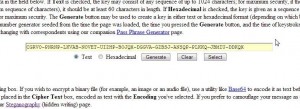
4. The site describes the difference between a Text key and a Hexadecimal key. We’ve used a Text key but read the description and make your own decision. Next comes the message:
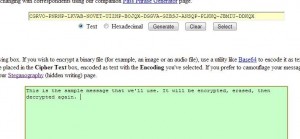
Enter the text in the green box. Don’t worry about length at this point. You can always send long messages in multiple emails.
5. Once the text has been entered and you have chosen a key, kit the Encrypt button:
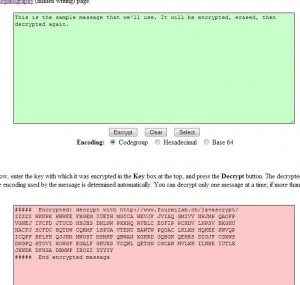
6. So far we have two of the three parts we need. Let’s see how we get the third part. The encrypted message is in the pink zone. Let’s delete the original message from the green zone:
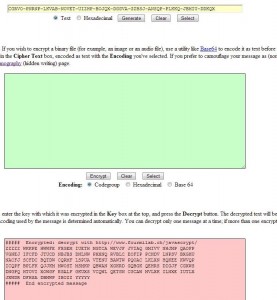
7. Move down to the pink area and set your cursor up in the top left corner and hit the Enter key to move everything down one line. That will leave an empty line at the top, right?
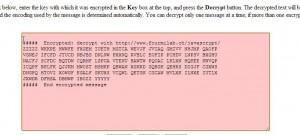
8. Go up to the key line, highlight it and click the right mouse button then choose Copy. Go back to the pink area and click in the empty line, right click and choose Paste:
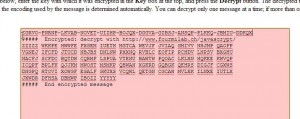
9. As long as the green box is empty, the message will reappear there as soon as you press the Decrypt button.
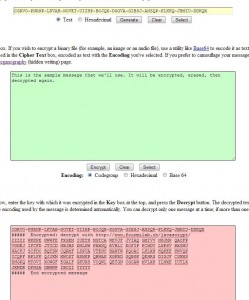
That’s it! You’ve just encrypted then decrypted a message than would be very hard to decrypt unless someone knew the key. How secure is this system? Secure enough that it would take a fairly long time for anyone to decrypt it, if indeed they could. The better the key, the more secure the message.
TIP: Keys are not a one-time, throwaway item. You could use a different key for each message but you could also use the same key for each friend. As long as someone has the key you used for encryption, they can decrypt your message.
If the key is easy for you and your friend/relative to remember, there is no need to write it down. Even so, you don’t want to send the key in an email, right? There are many ways to get the key to the person without using electronic means. Be creative!
This has been a long post but it’s an important topic, isn’t it? Let us know what you think about this or any other topic that’s important to you.
Thanks for reading!
